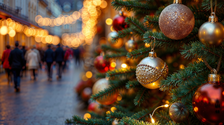Search from various English teachers...
Topics for You
Do you want to say something?
Editor's pick

Christmas in France: A Blend of History, Tradition, and Modern Warmth
7 likes · 5 Comments

A Taste of Christmas: Traditional Holiday Dishes Around Portugal
4 likes · 2 Comments

Buono, Bene, Bello: Understanding the Differences in Italian
1 likes · 0 Comments

Italian Passato Prossimo: When to use ‘essere’ and ‘avere’
3 likes · 0 Comments

Same Word, Different Meaning: American, British, and South African English
9 likes · 3 Comments

How to Sound Confident in English (Even When You’re Nervous)
11 likes · 9 Comments

Marketing Vocabulary and Phrases for Business English Learners
6 likes · 2 Comments

10 Strong Verbs to Use in a Job Interview
9 likes · 1 Comments

Five Classics of Portuguese literature: The most popular books
10 likes · 3 Comments

Fare vs. Essere: How to talk about the weather in Italian
4 likes · 3 Comments
More articles



